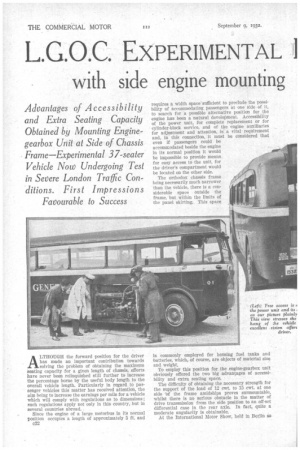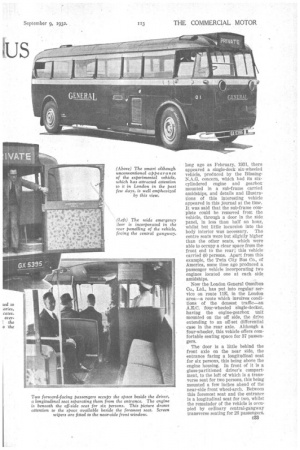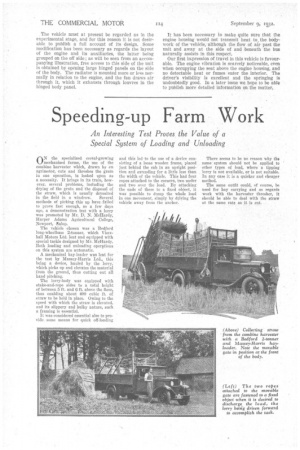L.G.O.C. EXPERIMENTAL
Page 54

Page 55

Page 56

If you've noticed an error in this article please click here to report it so we can fix it.
with side engine mounting
Advantages of Accessibility and Extra Seating Capacity Obtained by Mounting Enginegearbox Unit at Side of Chassis Frame—Experimental 37-seater Vehicle Now Undergoing Test in Severe London Traffic Conditions. First Impressions Favourable to Success
ALTHOUGH the forward position for the driver has made an important contribution towards solving the problem of obtaining the maximum seating capacity for a given length of chassis, efforts laave never been relinquished still further to increase the percentage borne by the useful body length to the overall vehicle length. Particularly in regard to passenger vehicles this matter has received attention, the aim being to increase the earnings per mile for a vehicle which will comply with regulations as to dimensions; such regulations apply not only in this country, but in several countries abroad..
Since the engine of a large motorbus in its normal position occupies a length of approximately 5 ft. and c32 requires a width space'sufficient to preclude the possibility of accommodating passengers at one side of it, to search for a possible alternative position for the engine has been a natural development. Accessibility of the power unit, for complete replacement or for cylinder-block service, and of the engine auxiliaries for adjustment and attention, is a vital requirement and, in this connection, it must be considered that even if passengers could be accommodated beside the engine In its normal position it would be impossible to provide means for easy access to the unit, for the driver's compartment would be located on the other side.
The orthodox chassis frame being necessarily much narrower than the vehicle, there is a considerable space outside the frame, but within the limits of the panel skirting. This space Is commonly employed for housing fuel tanks and batteries, which, of course, are objects of material size and weight.
To employ this position for the engine-gearbox unit obviously offered the two big advantages of accessibility and extra seating space.
The difficulty of obtaining the necessary strength for the support of the load of 12 cwt. to 15 cwt. at one side -of the frame amidships proves surmountable, whilst there is no serious obstacle in the matter of drive transmission from the side position to an off-set differential case in the rear axle. In fact, quite a moderate angularity is obtainable.
At the International Motor Show, held in Berlin so long ago as February, 1931, there appeared a single-deck six-wheeled vehicle, produced by the BiissingN.A.G. concern, which had its sixcylindered engine and gearbox mounted in a sub-frame carried amidships, and details and illustrations of this interesting vehicle appeared in this journal at the time. It was said that the sub-frame complete could be removed from the ve.hicle, through a door in the side panel, in less than half an hour, whilst but little incursion into the body interior was necessary. The centre seats were but slightly higher than the other seats, which were able to occupy a clear space from the front end to the rear ; this vehicle carried 60 persons. Apart from this example, the Twin City Bus Co., of _America, some time ago produced a passenger vehicle incorporating two engines located one at each side amidships.
Now the London general Omnibus Co., Ltd., has put into regular. service on route 11E, in the London area—a route which involves conditions of the densest traffic—an A.E.C. four-wheeled single-decker, having the engine-gearbox unit Mounted on the off side, the drive extending to an off-set differential case in the rear axle. Although a four-wheeler, this vehicle offers comfortable seating space for 37 passengers.
The door is a little behind the front axle on the near side, the entrance facing a longitudinal seat for six persons, this being above the engine housing. In front of it is a glass-partitioned driver's compartment, to the left of which is a transverse seat for two persons, this being mounted a few inches ahead of the near-side front wheel-arch. Between this foremost seat and the entrance is a longitudinal seat for two, whilst the remainder of the vehicle is occupied by ordinary central-gangway transverse seating for 26 passengers.
The vehicle must at present be regarded as in the experimental stage, and for this reason it is not desirable to publish a full account of its design. Some modification has been necessary as regards the layout of the engine and its auxiliaries, the latter being grouped on the off side; as will be seen from an accompanying illustration, free access to this side of the unit is obtained by opening large hinged panels on the side of the body. The radiator is mounted more or less normally in relation to the engine, and the fan draws air• through it, which it exhausts through louvres in the hinged body panel.
It has been necessary to make quite sure that the engine housing would not transmit heat to, the bodywork of the vehicle, although the flow of air past the unit and away at the side of and beneath the bus naturally assists in this respect.
Our first impression of travel in this vehicle is favourable. The engine vibration is scarcely noticeable, even when occupying the seat above the engine housing, and no detectable heat or fumes enter the interior. The driver's visibility is excellent and the springing is undoubtedly good. In a later issue we hope to be able to publish more detailed information on the matter.












































































































